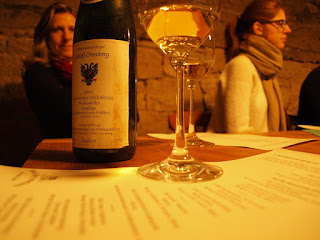How many
bottles of wine do you store in you cellar? Ten, twenty or even a hundred? What
about 40.000!? Yes, forty thousand. That’s the number of bottles that an
elderly married couple in Würzburg, Franconia, collected over the last 40
years. And this are just the bottles which were stored away. Uncounted the
wines that were drunk by Wolfgang and Luise Koegel, since they were infected
with the wine-virus back in the 1970s. They made it their hobby to drive
through the German wine regions and visit wineries almost each weekend.
 |
| Ten out of forty thousand |
But what to
do with those wines? Taken by inquisitiveness about this hoard, Martin agreed
to care about this fanciful assortment. The challenge was not only the mere
number of the bottles but also that there were almost no duplicates, which made
it barely impossible to commercialize this selection. By another coincidence the
Vinum wine magazine got attention of this. This and the fact that the Koegls
had no commercial interest with their wine heritage saw to it, that they bore
the idea to salvage this for charity purposes.
 |
| Tasting for charity |
Besides
this, Martin hosts a surprise wine tasting of ripe wines each month. Lucky me,
I could attend one of this tastings. We had a line-up of ten white wines of
vintages between 1976 and 1993, dominated by the German Riesling grape, but
also one of Muskateller, of a Traminer and of a Scheurebe. One surprise was,
that all of the wines were still drinkable, but the bigger surprise was how excellent
some developed and matured. Especially Riesling with some residual sugar
matures pretty well. The typical fruity flavors are complemented by balmy notes
like honey, resin or wax.
You need not to collect 40.000 bottles but you could consider to store away some of your favorite wines for later. Much later! Ah, and if you don’t want to wait until then, I know from good authority, that there are still some surprise packages left. You could try to get one via the Vinum magazine (www.vinum.de/weinsammlung). See also www.winesaveslifes.de and www.sommerhausen.com for more information.
 |
| 1993 Ortenberger Schloßberg Muskateller Spätlese |
 |
| 1989 Wachenheimer Fuchsmantel Riesling Spätlese |
 |
| 1984 Schloßböckelheimer Kupfergrube Riesling |
 |
| 1983 Forster Ungeheuer Riesling Spätlese trocken |
 |
| 1983 Niersteiner Petersberg Scheurebe Spätlese |
 |
| 1983 Dürkheimer Michelsberg Riesling Auslese |
 |
| 1976 Johannisberger Hölle Riesling Auslese |



